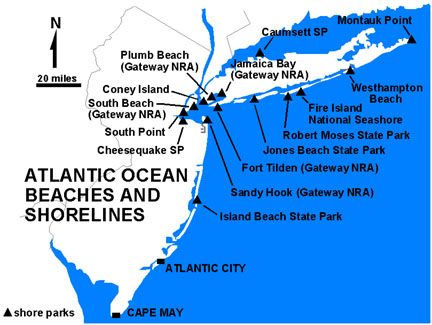Field Trips to the Shore
Undeveloped sections of the coast provide an opportunity to examine how nature intends the shoreline to appear and behave. However, there is incredibly little coastline that hasn't been affected. The localities shown on Figure 173 are preserves and recreational areas that feature coastal environments ranging from relatively undisturbed to completely artificial environments. Although each of these sites share many similarities, they also have unique environmental conditions relating to local sediment supply, storm, wave, and tidal energy, and impacts by human coastal modifications and pollution.
 |
| Figure 173. Map of selected beach, barrier, and bay localities in the New York City region. |
Planning your trip to the beach
Planning a trip to the beach is potentially good or bad any time of year in the New York Bight. Certainly, weather is always of primary concern, and alternatives should be planned in advance. Some of the best times to go beach combing occur in the dead of winter, particularly on a clear morning when the wind and waves are calm. The secret is being dressed appropriately and prepared for sudden changes. A long walk on a cold, windy beach can set the stage for hypothermia or frost bite if unprepared. Conversely, heat exhaustion and dehydration are a risk during the summer. Sunburn is a problem anytime of year. If you see a storm approaching or hear thunder get off the beach and into shelter immediately! Never, never underestimate the power of lightning. If the time between flashes and claps can be measured in seconds, you are already in danger. Shelter inside a building or car is the safest option; do not stand under trees or near tall structures (like lighthouses). Get off the beach.
While walking on the beach or picking through the wracklines it is important to be aware of rusty objects, broken glass, medical wastes, etc. Tar balls, grease, and other compounds can ruin clothes or can be quite toxic. As mentioned above, massive die-offs of shellfish can create a very smelly, even unhealthy experience. In general, if you don't know what it is, or if you can smell it, don't touch it! (Or, carefully dispose of it if if it belongs in the trash). It is wise not to have your back to the ocean during times of high surf. "Sleeper waves" catch, and even kill people every year. In the back beach area learn to recognize poison ivy. It is easy to recognize its three leaves, but most people ignore to learn to spot its hairy vine. In addition, wind-blown sand can pick up the oils and transport them down wind. It is possible to contract poison ivy any time of year. Likewise, the underbrush on back beach areas and on barrier islands is an ideal habitat for both deer and wood ticks, as well as a variety of very viscous mosquitoes and other biting insects, particularly in the late spring and summer.
Wearing old, worn out or water-proof shoes is always recommended. Don't spoil a trip by not being prepared! It is highly advisable to call ahead before planning a trip, and check weather forecasts before you leave. Early morning in the summer, and early afternoon in the fall, winter, and spring are the best time to go, especially two days after a good storm when the surf dies down, and when the tides are waning a couple days after either a full or new moon. Bring a camera, field guides (birds and sea shore critter books) drinks, food for a picnic, a towel, extra clothes, garbage bags, but nothing more than will fit in a day pack. Plan to make a full day trip. Usually the scenery and experience will make the trip more than worthwhile.
Selected shore field trip destinations include:
66. Island Beach State Park
67. Sandy Hook (Gateway National Recreation
Area)
68. South Beach, Staten Island
69. Breezy Point/Fort Tilden (Gateway National
Recreation Area)
70. Jamaica Bay (Gateway National Recreation
Area)
71. Plumb Beach (Gateway National Recreation
Area)
72. Coney Island
73. Jones Beach State Park
74. Robert Moses State Park/Fire Island National
Seashore
75. Westhampton Beach
However, be sure to check these selected shore destination sites as well (discussed in previous sections):
50. Cheesequake State Park
63. South Point, Staten Island
64. Caumsett State Park
65. Montauk Point
| Return to Our Transient Coastal Environment. |